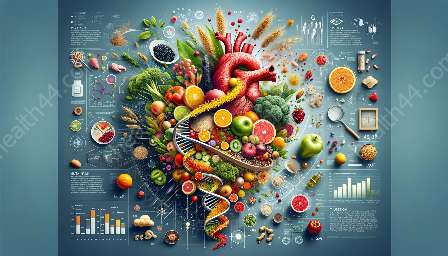Food processing and cooking methods play a crucial role in determining the availability and activity of nutrients in the foods we consume. In this comprehensive guide, we will delve into the intricate relationship between food processing, cooking techniques, and their impact on the bioavailability and bioactivity of essential nutrients.
Understanding Nutrient Bioavailability and Bioactivity
Before we explore the effects of food processing and cooking on nutrients, it's essential to understand the concepts of bioavailability and bioactivity. Nutrient bioavailability refers to the proportion of a nutrient that is absorbed from the diet and utilized for normal physiological functions. Bioactivity, on the other hand, pertains to the physiological effects that nutrients exert on the body once they are absorbed.
A variety of factors influence the bioavailability and bioactivity of nutrients, including the chemical form of nutrients, interactions with other dietary components, and the structural integrity of food matrices. Food processing and cooking can significantly alter these factors, thereby impacting the overall nutritional quality of foods.
Impact of Food Processing on Nutrient Bioavailability
Food processing encompasses a wide range of techniques aimed at transforming raw ingredients into consumable products. Some common food processing methods include canning, freezing, drying, and milling. The impact of food processing on nutrient bioavailability varies depending on the method employed and the type of nutrients present in the food.
Effect of Heat Processing
Cooking through heat processing is one of the most prevalent methods of food preparation. It can enhance the bioavailability of certain nutrients while diminishing that of others. Heat processing can improve the bioavailability of carotenoids, such as beta-carotene found in carrots and spinach, by breaking down plant cell walls and releasing these compounds for absorption.
On the other hand, heat processing can lead to the loss of water-soluble vitamins like vitamin C and B vitamins due to their sensitivity to heat and oxidation. Boiling, in particular, can cause leaching of these vitamins into the cooking water, leading to a reduction in their concentration in the food.
Effect of Mechanical Processing
Mechanical processing techniques, such as milling and grinding, are commonly used to refine grains and cereals. While these processes may improve the sensory properties and texture of foods, they can also strip away the outer layers of grains, which contain essential nutrients like fiber, vitamins, and minerals. As a result, the bioavailability of these nutrients may be reduced in processed grain products compared to whole grains.
Effect of Preservation Methods
The preservation of foods through canning, freezing, and drying can have varying effects on nutrient bioavailability. While these methods are essential for extending the shelf life of perishable foods, they can also cause nutrient losses. For instance, the blanching and freezing of vegetables can lead to the degradation of heat-sensitive nutrients like vitamin C and certain phytochemicals.
Enhancing Nutrient Bioavailability through Cooking Techniques
Although some food processing methods may reduce nutrient bioavailability, certain cooking techniques can enhance the availability of nutrients in foods.
Effect of Culinary Techniques
Certain culinary practices, such as soaking, fermenting, and sprouting, can positively influence the bioavailability of nutrients. Soaking legumes and grains before cooking can help reduce antinutrients like phytates and tannins, which can hinder the absorption of minerals like iron and zinc. Fermentation of foods, as seen in the production of yogurt and sourdough bread, can improve the bioavailability of nutrients and lead to the synthesis of beneficial compounds, such as certain B vitamins and probiotics.
Use of Healthy Cooking Oils
The choice of cooking oils can also impact the bioavailability of nutrients. Cooking with healthy oils rich in unsaturated fats, such as olive oil, can facilitate the absorption of fat-soluble vitamins like vitamin E and K. Additionally, incorporating healthy fats in cooking can enhance the bioavailability of fat-soluble phytochemicals found in fruits and vegetables.
Influence of Food Processing on Nutrient Bioactivity
Food processing methods can not only affect nutrient bioavailability but also influence the bioactivity of nutrients in the body. Bioactive compounds, including phytochemicals, antioxidants, and polyphenols, contribute to the health-promoting properties of foods and can be altered during processing.
Impact on Phytochemicals and Antioxidants
Phytochemicals are bioactive compounds found in plant-based foods, with potential health benefits such as antioxidant, anti-inflammatory, and anti-cancer properties. However, the concentration and bioactivity of phytochemicals can be influenced by food processing methods. For instance, the exposure of fruits and vegetables to heat during cooking can lead to the degradation of heat-sensitive antioxidants, potentially reducing their bioactivity.
Probiotics and Fermented Foods
Fermented foods, such as yogurt, kimchi, and kefir, contain live microorganisms with probiotic properties. The fermentation process itself serves to enhance the bioactivity of these foods by increasing the levels of beneficial bacteria, which can contribute to gut health and immune function. However, the preservation and storage of fermented products can impact the viability of probiotics, affecting their bioactivity.
Conclusion
The impact of food processing and cooking methods on nutrient bioavailability and bioactivity is multifaceted. While certain processing methods can diminish the availability and activity of nutrients, others may enhance them. Understanding these dynamics is crucial for making informed dietary choices and maximizing the nutritional benefits derived from the foods we consume.


